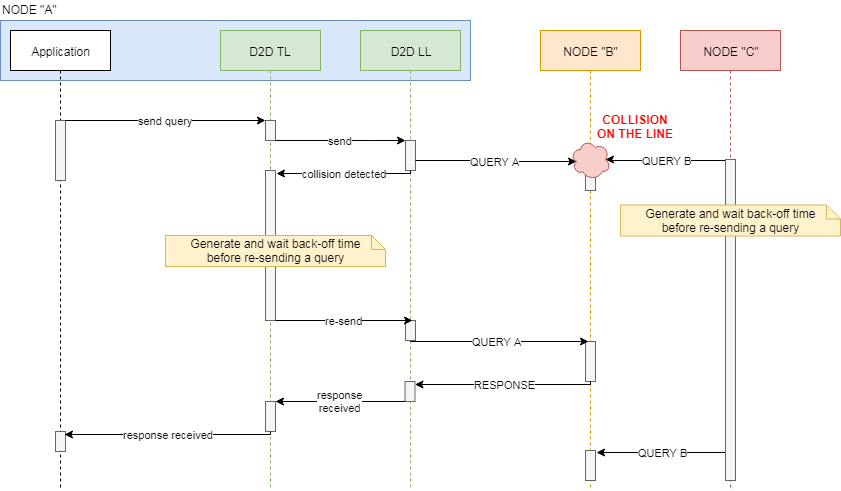D2D - Introduction¶
Introduction¶
Devices to Devices (D2D) is a library for communication from Devices to Devices. It uses single write hardware connection that reduces amount cables. The library supports a Mutli-Point (Mutli-Master) topology and it is easy to used with different microcontrollers. The application protocol can be defined, as it is not imposed on the user. The Physical Layer implementation depends completely on the uses, so that the library may be used to transmit data by serial interfaces and wireless interfaces as well.
It is intended for the embedded systems like:
- IoT devices
- Various types of robots
- Home Appliance devices (Washers, Dryers, Fridges, ..)
- etc.
that contain or interface several Nodes.
The main features of the D2D are:
- Portability (written in simple C)
- Multi-master (Multi-point) solution (any device can send to any device with one common cable for all)
- Reduction of hardware connections (simple transmission and reception circuit)
- Supports frames collision and handling
- Layered design easy to plug-in on each level
Note
The D2D library can be used for the interfaces that supports peer-to-peer model on the Physical Layer. The addressing is done inside the library within frame header.
Communication scheme¶
The D2D library assumes the request and response communication scheme. Request is called Query and Response is just called Response. The communication scenario is depicted on the below picture.
Note
- Request message is called Query.
- Response message is called Response (to the Query).

The Node A sends a Query to the Node B and Node B responds to
Node A with a Response.
In case of a Query sending failure, the seneder re-transmits the Query to the recipient. Number of the re-transmissions is settable in the library. There are two types of sending failure:
- Sending timeout
- (Optional) Sending collision
Sending timeout happens when after giving a send request to the library, the frame cannot be sent because of e.g. lack of peripheral resources. In that case the Link Layer informs upper layers about such event and re-transmission is performed. The re-transmission is executed immediatelly after timeout expiration.

Sending collision describes a case when Link Layer is informed about a collision during sending the data over the medium. In UART example it is possible, because the transmitted signal (TX line) goes back in a loop to the sender (RX line). This echo signal is used to compare transmitted and received byte. If collision happens the Link Layer informs upper layers about such event and re-transmission is performed. Re-transmission is executed after some time which is called a back-off time. The back-off time is generated randomly, so that it reduces possibility of next collision.
Note
In contrary to the Query, there is no Response re-transmission. It implies that when the Response was not sent properly by some Node, it waits for the Query sender to re-transmit the Query. When Query arrives the receiving Node has a chance to send a Response once again.

Messages format¶
The Query and Response messages have common format which is shown below. There is no differentiation between a Query and Response. The Response data content depends completely on the user, so that the user may decide to carry some useful information or send just zero-length data as a Response. The zero-length response may be assumed as an acknowledge. In genral, when the Response does not come back, it means that the sender has to re-transmit the Query.

The colored blocks tells what D2D layers are responsible for what data parts. The message contains following fields:
Sync1- Frame synchronization byte (0xAE)MsgId- Message identification number. The MsgId is the same for the Query and Response.Sender- Sender Node address.Recipient- Recipient Node address.Length- Number ofDatabytes.Data- User data bytes.CRC- Checksum value that prevents from receiving distorted frames.
The MsgId field play an important part in the messaging strategy. All the Responses
and all the Query re-transmitions shall carry the same MsgId value. The only
exception is when one of the Nodes had an internal issue during the valid communication.
Messaging suggestions¶
In a Query recipient Node point of view, if receives a valid Query and responds to it with a Response, it shall wait at least one re-transmission timeout, and after that time it can sure that the Query sender Node received its response properly.
However if a Query sender Node during receiving a Response had an internal issue (e.g. HW reset), it shall send the Query again to the recipient Node. In that situation the Query recipient Node might think that the Response to the first Query had been delivered back successfully. If it receives a new Query it shall accept it and respond with some data.
What next¶
Feel free to see next articles that describe in details how to use D2D library.
Footnote
kaeraz, 2019/02